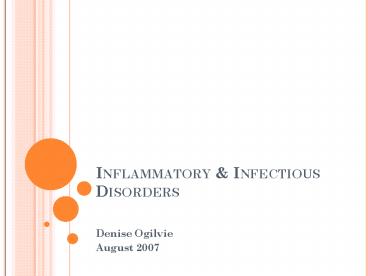Inflammatory - PowerPoint PPT Presentation
1 / 29
Title:
Inflammatory
Description:
As a result of inflammation, erosion of articular cartilage and underlying bone. ... Erosion of the articular cortex may produce irregular cyst like lesions with ... – PowerPoint PPT presentation
Number of Views:135
Avg rating:3.0/5.0
Title: Inflammatory
1
Inflammatory InfectiousDisorders
- Denise Ogilvie
- August 2007
2
Arthritis
- Inflammation of a joint
- 90 of cases are osteo and rheumatoid arthritis
- Women are 3 times more likely to be affected than
men - Average age of onset in adults is 40years of age
3
Rheumatoid Arthritis
- A chronic systemic inflammatory disorder
- Characterised by joint destruction
- Also involves muscles, heart, lungs, blood
vessels and skin. - Begins as inflammation of synovial membrane that
lines the joints
4
Rheumatoid Arthritis
- As a result of inflammation, erosion of articular
cartilage and underlying bone. - Fibrous scarring and bony fusion across the joint
may occur - The fusion of joint surfaces and involvement of
ligaments leads to crippling deformities
5
Rheumatoid Arthritis
- Radiographic Appearance
- Earliest evidence is soft tissue swelling caused
by joint effusion and synovial inflammation - Disuse and increased blood flow leads to
osteoporosis of bone near the joint and
eventually the whole bone
6
Rheumatoid Arthritis
- Periarticular Osteoporosis
7
Rheumatoid Arthritis
- Small areas of destruction at edges of joint
where the articular cartilage is absent - Destruction of articular cartilage causes
narrowing of joint space - Bony trabeculae laid down across the joint
8
Rheumatoid Arthritis
- Ligamentous involvement causes contraction and
subluxation causing the common ulna deviation of
hands
9
Osteoarthritis
- A degenerative joint disease as a result of loss
of joint cartilage and reactive bone formation - Also as result of wear and tear with age
- Can be secondary form of degeneration as a result
of trauma
10
Osteoarthritis
- Predominantly affects weight bearing joints
hips, knees, ankles and interphalangeal joints of
the fingers
11
Osteoarthritis
- Radiographic Appearance
- Earliest signs joint space narrowing caused by
thinning of articular cartilage and development
of bony spurs osteophytes
12
Osteoarthritis
- Joint space narrowing is irregular and more
pronounced in weight bearing joints
13
Osteoarthritis
- Articular ends become increasingly dense
periarticular sclerosis - Erosion of the articular cortex may produce
irregular cyst like lesions with sclerotic
margins near the joint - Ossified loose bodies may develop, especially in
knee and also elbow
14
Osteoarthritis
- In fingers often involves distal interphalangeal
joints
15
Infectious Arthritis
- Pus forming organisms enter the joint by direct
contact with osteomyelitis or from joint trauma - Bacterial infection high fever, shaking chills,
some swollen and tender joints - Most common type is a migratory arthritis from
Lyme Disease
16
Infectious Arthritis
- 6 weeks after onset ofacute staphloccal arthritis
- Pronounced cartilage and bone destruction with
sclerosis
17
Infectious Arthritis
- Radiographic Appearance
- Soft tissue swelling
- In children fluid distension of the joint
capsule causing widening of the joint space and
subluxation. Especially hips, shoulders - Rapid destruction of articular cartilage causing
joint space narrowing
18
Infectious Arthritis
- Earliest bone changes occur 8-10 days after onset
of symptoms small areas of erosion of articular
bone - Untreated causes destruction and loss of cortical
outline - Healing sclerotic bone reactions forms
irregular articular surface
19
Treatment of Arthritis
- Aim is to protect affected joints, maintain
mobility and strengthen muscles - Rest to minimise inflammation and preserve rang
of motion - Medication anti inflammatories to decrease
inflammation - Antibiotics may be used to treat infection
20
Bursitis
- Inflammation of the bursa
- Small fluid filled sac near joints
- Can be caused by repeated physical activity
- Also trauma, rheumatoid, gout or infection
- Not usually seen on plain film u/s better
- Plain film will exclude other disorders
21
Bursitis
- Radiographic Appearance
- Can see deposits of calcification in adjacent
tendons - This can cause pain and limitation in movement
- Shoulder supraspinatous tendon
- U/S reveal bursa with fluid
22
Bursitis
- Treatment
- Anti inflammatories to reduce swelling and pain
- Cortico steroid injections into the affected
bursa
23
Bacterial Osteomyelitis
- Inflammation of bone and bone marrow caused by
infectious organisms - In children the metaphysis of long bones commonly
affected femur tibia - Staphlococci and streptococci are most common
causes
24
Bacterial Osteomyelitis
- Experience fever, localised warmth, swelling and
tenderness - In adults common in vertebrae causing back pain
and spasms - Treated with antibiotics
- Can develop as result of IV drug use
25
Bacterial Osteomyelitis
- In diabetic patients soft tissue infection may
spread skin abscess usually foot causing
cellulitis and eventually osteomyelitis of nearby
bone - Begins as abscess in the bone
- Pus from inflammation spreads down medullary
cavity and outward to the surface - It then raises the periostium
26
Bacterial Osteomyelitis
- Early stages may not be seen on plain film until
about 10 days after the onset of symptoms - Nuclear bone scan best imaging technique for
early diagnosis - Plain film earliest evidence in long bones
27
Bacterial Osteomyelitis
- Initial bony change appears as subtle areas of
lucency, leading to ragged moth eaten appearance
28
Chronic Osteomyelitis
- Eventually new bone laid over cortex
- After infection subsides bone becomes thickened,
sclerotic with irregular margins
29
Reference
- Eisenberg, R, Johnson, N, Comprehensive
radiographic pathology, 4th edn - Scally, P, Medical imaging, OxfordMedical
Publications































